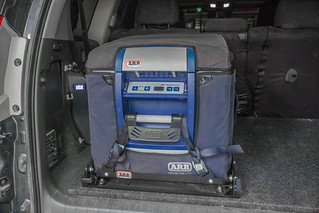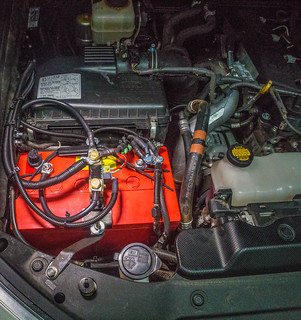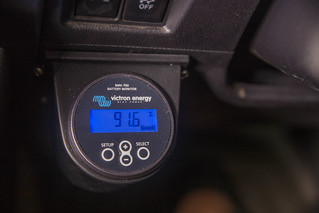CC licensed Flickr image by sridgway
In order to power a fridge and 12v accessories it's essential to have a separate or Auxiliary (AUX) battery installed in your 4WD so that your primary starter battery is not discharged while the engine is not running. It's best to get this work done by a professional, however in this post I will consider some of the options to consider so you might be more informed when making your decisions.
Some of the things to consider are :-
- What type of battery is best suited to this task and what battery capacity is required?
- How is the AUX battery going to be charged when the engine is running?
- How is the main battery isolated from being discharged when the motor is not running?
- Can solar power be used to charge the battery when the motor is not running ?
- How do I know when the battery needs to be charged?
Typically most 4WD's have room provisioned for an additional AUX battery so all that is required is to install a new battery, charging system and wiring, typically to a fridge.
Deep Cycle or AGM (Absorbed Glass Matt) batteries are commonly recommended for this application as they are designed for slow discharge over time however a standard lead acid (wet cell) will work fine. There is lots of information on the web about the reasons for selecting AGM so you can research this for yourself in more depth. Despite the higher cost AGM batteries are more robust in 4WD situations, are totally sealed requiring no topping up, charge faster with lower internal resistance and can be infrequently discharged to lower levels without damage. A decent quality 100 Ah AGM battery will set you back around $350-$400.
What size battery is best?
Well this largely depends of the space in your vehicle, most 4wd have space for a AUX battery. 12 volt automotive battery capacity is rated in Amp Hours, a unit of measurement for battery capacity obtained by multiplying a current flow in amperes by the time in hours of discharge. There is a industry standard that 12 volt automotive batteries are rated over a 20 hour discharge period. So for example, a battery which delivers 5 amperes over 20 hours till discharged delivers 5 amperes times 20 hours, or 100 ampere-hours. The larger the Ah rating of a battery the longer it will deliver a given load for until it needs recharging. 100-150 Ah is a very typical range used for an AUX battery in a 4WD running a fridge and a few accessories. The other factor to consider is that as a general rule lead acid batteries should not be discharged below 50 % of their rated capacity. So although you might have a 100 Ah battery, in reality you can only use it as if it were a 50 Ah. You can go below 50% but you risk reducing the life of the battery or damaging it permanently.
How to charge the battery when the engine is running?
The vehicle alternator is used to charge the starter battery and is also used as the source of energy to charge the AUX battery when the engine is running. The AUX battery also need to be isolated from the main battery when the engine is off so the starter battery is not discharged.
There a 2 methods typically used to achieve this. The cheapest and simplest method is to install a solenoid which connects the starter and AUX batteries in parallel when the engine is running so the alternator charges both simultaneously. When the engine is off the solenoid isolates the AUX battery.
The alternative method is to use a dedicated battery charger which detects the type of battery and dynamically charges the battery to ensure the most efficient charge. While more expensive, typically $300 they will ensure the battery is kept is the best condition possible. They also isolate the AUX battery. There are many chargers on the market the Redarc BCDC1225 also have a separate solar input and MPPT charger so solar panels can be used to charge the AUX battery at camp. An essential item if you camp without driving for extended periods.
AGM Battery mounted in Prado 150 with a DC/DC charger (top left)



